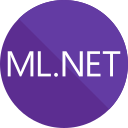 | |
| Original author(s) | Microsoft |
|---|---|
| Developer(s) | .NET Foundation |
| Initial release | 7 May 2018[1] |
| Stable release | 3.0.0
/ 28 November 2023 |
| Preview release | 3.0.0-preview.23511.1
/ 14 October 2023 |
| Repository | github |
| Written in | C# and C++ |
| Operating system | Linux, macOS, Windows[2] |
| Platform | .NET Core, .NET Framework |
| Type | Machine learning library |
| License | MIT License[3] |
| Website | dot |
ML.NET is a free software machine learning library for the C# and F# programming languages.[4][5][6] It also supports Python models when used together with NimbusML. The preview release of ML.NET included transforms for feature engineering like n-gram creation, and learners to handle binary classification, multi-class classification, and regression tasks.[7] Additional ML tasks like anomaly detection and recommendation systems have since been added, and other approaches like deep learning will be included in future versions.[8][9]
- ^ Ankit Asthana (2017-05-07). "Introducing ML.NET: Cross-platform, Proven and Open Source Machine Learning Framework". blogs.msdn.microsoft.com. Retrieved 2018-05-10.
- ^ "ML.NET: Machine Learning made for .NET". Microsoft. Retrieved 11 May 2018.
- ^ at master · DotNet/MachineLearning
- ^ David Ramel (2018-05-08). "Open Source, Cross-Platform ML.NET Simplifies Machine Learning -- Visual Studio Magazine". Visual Studio Magazine. Retrieved 2018-05-10.
- ^ Kareem Anderson (2017-05-09). "Microsoft debuts ML.NET cross-platform machine learning framework". On MSFT. Retrieved 2018-05-10.
- ^ Ankit Asthana (2018-08-07). "Announcing ML.NET 0.4". blogs.msdn.microsoft.com. Retrieved 2018-08-08.
- ^ Gal Oshri (2018-05-06). "ML.NET 0.1 Release Notes". GitHub. Retrieved 2018-05-10.
- ^ Tiwari, Aditya (2018-05-08). "Microsoft Launches ML.NET Open Source Machine Learning Framework". Fossbytes. Retrieved 2018-05-10.
Over time, it will enable other ML tasks like anomaly detection, recommendation system, and other approaches like deep learning using the benefits of added libraries.
- ^ "Machine learning tasks in ML.NET". Microsoft. Retrieved 26 December 2018.